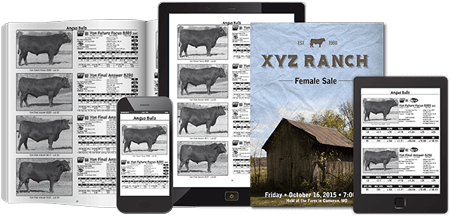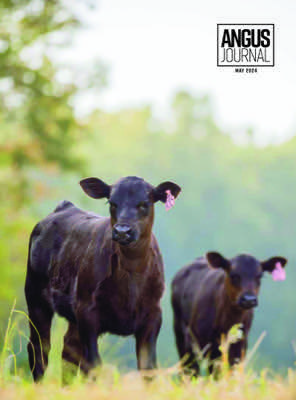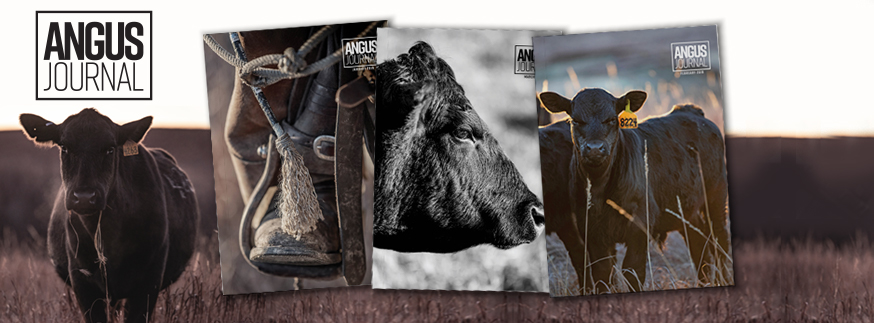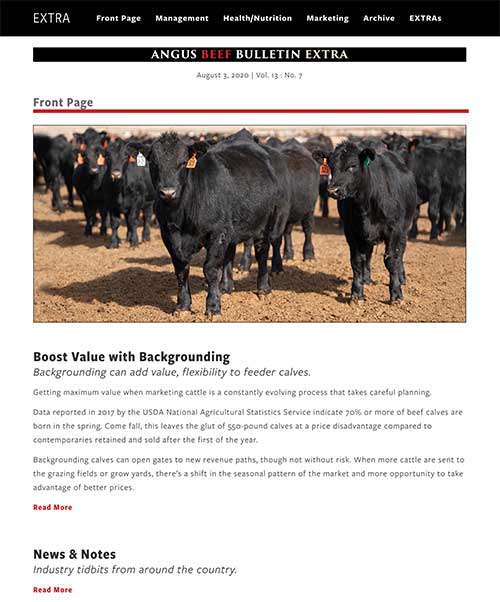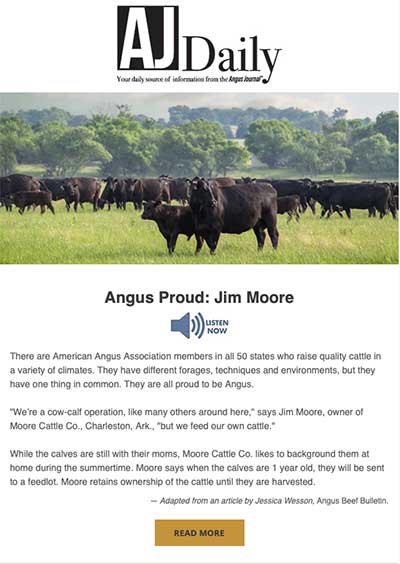Bull Selection Guide
By Austin Black
|
Angus Beef Bulletin
1/23/2017
Sale season is just around the corner. For bull buyers, it can be a stressful couple of months. Looking at sale books, walking through pens and sitting ringside is time-consuming. Planning ahead can ease the stress and help make the selection process a little easier. Following are five steps that will help bull buyers pick their next herd sire.
1. Establish your needs
One of the greatest challenges bull buyers face is deciding what they need in a bull. Some bulls excel in carcass traits and yearling weight. Others sire great replacement heifers, and there’s always bulls advertised for their calving ease and low birth weight. However, not every bull is the right choice for every operation. Travis Meteer, University of Illinois beef cattle specialist, said producers should align their bull selection criteria with their herd goals.
This starts with identifying their desired markets.
“One of the best parts about the cattle industry is the different ways producers achieve their goals,” Meteer said. Many commercial operations sell calves at weaning, though some retain ownership in the feedyard. Other producers focus on raising replacement heifers. Some finish cattle themselves and sell freezer beef. Each of these markets requires a different set of traits. Knowing the desired market helps producers focus on bulls that excel in these areas.
Traits are often classified as terminal or maternal. Terminal traits focus on carcass, marbling and yearling weight. Maternal traits cater more toward birth weight, weaning weight, milk and mature cow size. Producers should know if bulls are classified as having terminal or maternal traits.
2. Have a budget
It’s easy to go to a sale and get carried away bidding on a favorite lot. Part of the selection process includes finding a bull that’s affordable. Producers know that bull prices fluctuate according to the market. The standard rule of thumb of how much to spend on a bull is twice the price of a fat steer. Meteer said in an average bull sale, the average price will often be comparable to this formula.
There are always high-dollar lots that go above this price point. Some producers have markets that offer a premium on cattle sold. They may sell bred heifers in special sales, feed calves in a branded beef program or market through value-added sales. Any of these market channels can offer premiums that justify spending more money on a good bull.
“If you can make a 10¢ premium on calves, selling 100 head at 500 pounds with a 10¢ premium is an extra $5,000,” Meteer said.
Even if producers don’t have special markets, a bull that excels in traits that benefit their operation is valuable. He could impact a herd for the next five to 20 years in some cases.
“If you find a bull that has the traits you’re looking for — buy him. Buy a bull that adds value to your calves and your cow herd,” he said.
3. Look at phenotypes
Some bulls look better on paper than they do in real life. Producers should make sure the bull has the conformation traits necessary to do the job.
“First and foremost, a bull needs to function,” Meteer said. The bull’s job is to breed as many cows as possible in a limited amount of time. This requires him to be structurally sound, have adequate condition and a strong libido.
Producers should pay attention to hoof health and shape, testicle size and leg movement. This will show if the bull is able to cover ground and breed the number of cows expected. Docility is important, too, especially if labor or facilities aren’t readily available.
Meteer said most seedstock producers screen bulls for these traits before selling. It’s important to take note of any potential issues and compare bulls.
“Buying bulls that are raised in similar conditions to your farm is preferred,” he said. “You can buy someone else’s genetics, but you can’t buy their management.”
4. Compare the numbers
Producers have several genetic and scientific tools to help with bull selection. The most common data measurement buyers use are expected progeny differences (EPDs). These numbers predict how a bull’s offspring will perform compared to his counterparts. There are several EPDs producers can use, and it’s easy to get overwhelmed. Meteer said it’s important to know which EPDs relate to a producer’s needs.
The most common EPDs that producers look at are calving ease (CE), birth weight (BW), weaning weight (WW), yearling weight (YW) and milk (MILK).
“The emphasis I always make to producers is to understand what those EPDs are,” Meteer said. Producers sometimes get confused and assume CE and BW go hand-in-hand.
“Birth weight is an indicator for calving ease, but you don’t get paid for light-birth-weight calves,” he said. BW EPDs aren’t as important as if the bull will service cows.
“When selecting bulls for use on mature cows, a middle-of-the-road calving-ease EPD may be sufficient and allow for emphasis on other traits,” he said.
If producers sell calves at weaning or keep replacement heifers, they should focus on calving ease, weaning weight and female fertility. EPDs for heifer pregnancy and stayability help measure that trait.
“If you retain ownership in your cattle through the feedlot and market to the packer, then yearling weight and carcass traits become more relevant to your bottom line,” Meteer said.
Using a dollar value index ($Value) helps compare bulls using these types of scenarios. They measure the economic impact of traits and help producers compare several traits together. The two most common indexes in the Angus breed are the weaned calf value ($W) index and the beef value ($B) index.
“[$W is] an index that is designed for cattlemen that primarily sell calves at weaning,” Meteer said. This index measures birth weight, weaning weight, milk and mature cow size. $W is considered a maternal index.
$B measures beef value and is a terminal index. Meteer said it’s important producers understand that distinction.
“It’s not an all-encompassing selection index,” he said. “It’s a great tool for cattlemen that are not keeping replacements. This index will increase profitability of cattle in the feedlot and on the grid,” he said.
For commercial cattlemen, sometimes it’s easier to note how a bull ranks in each EPD vs. studying the number itself. A bull in the top 25% or higher of his breed often excels in the respective trait. While it depends on the producer’s goals and environment, a bull with this ranking may be one to consider. Producers should also compare bulls within their ranks. For multi-breed comparison, producers can use adjustment factors from the Beef Improvement Federation (BIF). This allows equal measurement between breeds for commercial bull buyers.
The key to finding bulls with good EPDs is to look at the accuracy. Because young bulls haven’t sired any calves, there is minimal data to support the EPDs. Thus, numbers have a low accuracy. The more offspring a bull produces, the more data is collected and the more accurate his EPDs become.
Rather than waiting for years of data or taking a chance on a young bull’s performance, producers can use genomic-enhanced EPDs.
“Genomic-enhanced EPDs use DNA information as an additional source of data, along with the known pedigree, and the available performance and progeny information, to calculate the EPD values,” said Alison Van Eenennaam, University of California cooperative extension specialist.
By using DNA samples of the bull, scientists can determine which genes he inherited. This helps determine what areas he will improve with genetics. The result is increased accuracy of EPDs, especially on younger bulls. It hastens the time needed to get accurate numbers. Genomic-enhanced EPDs provide an accuracy that equals seven to 24 progeny test records.
“This gives bull customers added assurance that the true genetic merit of a young bull is not going to deviate too far from his EPDs. It’s a way to reduce risk associated with the purchase of a young sire,” Van Eenennaam said.
5. Find a reputable source
Do research on the operation selling the bull. It’s important for buyers to be comfortable with the seller and trust they’re getting a good bull. “I encourage bull buyers to develop a good working relationship with bull suppliers,” Meteer said. This gives an opportunity to learn about the management and background of the bull. Meteer said producers should know about herd health programs and nutrition. The latter is important as it dictates how bulls will respond to vaccinations and continued development.
“I suggest producers require a breeding soundness exam (sometimes referred to as a BSE),” Meteer said. Most bull suppliers do it as a routine, but it’s always important to make sure. He also suggested a quarantine period for new bulls. The selling process can be stressful on animals. Afterward, they need time to fight off potential sickness. This also protects the resident herd from any new pathogens the bull might carry.
“A minimum of two weeks will allow time for potential pathogens to break without exposing your herd,” Meteer said.
Find a good source, set your budget and buy the bull that will work best for you.
Editor’s Note: Austin Black is a freelance writer from Nevada, Mo.

